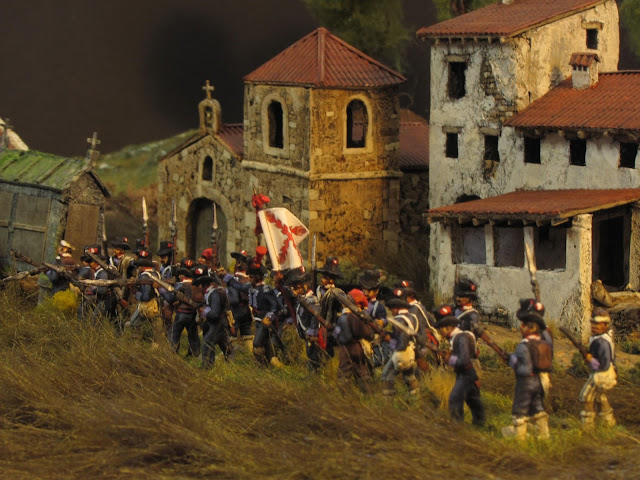
While my left eye is out of commission I figured I would tackle some French in greatcoats, a simpler painting proposition as I can avoid any piping on collars and cuffs. I still had a number of French left over from the HaT 1805-1808 French in Greatcoats set, some of which I had previously converted, so scalpel in hand I once again removed their bicorned heads and replaced them with shakoed heads from a box of 1805 Légere, also HaT (and a set full of stiff poses that I don't like!)
 |
| Figures with bicornes lopped off and shakos attached, to which I added covers and pompoms. |
 |
| Fusilier converted to standard bearer. The modelling is a bit rough byut works from a distance. |

A little history
Created in 1775 from two battalions of Aunis, the 32nd was reconstituted during the reorganization of the French army in 1803 into three battalions of 800 men each.
The 32nd (3rd battalion) marched with Junot into Portugal as part of the Gironde Observation Corps in 1807, entering Spain via Salamanca and arriving in Lisbon as part of the Army of Portugal in December 8, 1807. After Junot’s defeat at Vimiero the 32nd was repatriated to France by sea and reorganized, after which the first three battalions were sent to Spain as part of the 1st Division of the 4th Corps under General Sébastiani. The regiment subsequently participated in the battles of Talavera, Almonacid, Baza, Ocana and Vittoria as well as other engagements in the Peninsular War.
Regimental war record (Battles and Combats)
1791: Antilles
1793: Mainz
1795: Loano
1796: Montelgino, Dego, Lonato, Arcole and Saint Georges
1797: Rivoli and Mantoue
1798: Malta, Alexandrie and Les Pyramides
1799: El-Arish, Jaffa, Acre, Mont-Tabor, Aboukir and Damiette
1800: Heliopolis
1801: Alexandrie
1805: Haslach, Diernstein and Ulm
1807: Mohrungen and Friedland
1809: Talevera de de Reina and Almonacid
1810: Baza
1811: Ubida, Venta-del-Baul and Ticola
1812: Ocana
1813: Vittoria, Sorauren and Bayonne
1813: Lutzen,Wurschen, Buntzlau, Dresden and Leipzig
1814: Orthez and Toulouse
1814: Nogent-sur-Seine, Nangis, Monterau and Limonset
1815: Mundolsheim and Srasbourg








